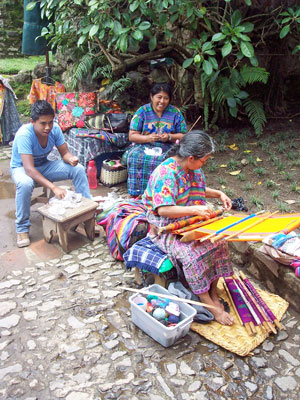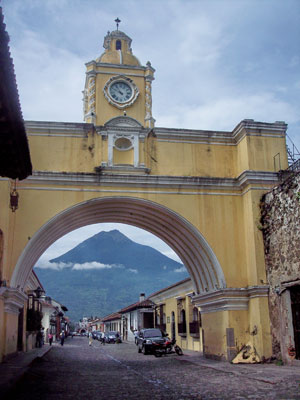Guatemala: Central American adventure
This item appears on page 63 of the October 2014 issue.
(Part 3 of 3)
The final portion of my June 2014 journey to Central America began with a 6-hour transfer by bus from Copán, Honduras, to Guatemala City, Guatemala, followed by a connecting minibus transfer to the beautiful and highly popular colonial city of Antigua.
Antigua charms
Built at 1,500 meters’ elevation in an earthquake-prone zone during the 16th century, Antigua was the seat of the Spanish-colonial government for the Kingdom of Guatemala, an area comprising parts of southern Mexico and all of Central America except Panama.
At its peak, in 1770, Antigua’s population was over 66,000, nearly double that of today (35,000-plus). Antigua’s 16th-century, baroque-style, monumental buildings have survived the passing centuries, mostly in ruins, along with the unique cobblestone streets which are found throughout the city.
It also features beautiful plazas, fountains and many fine examples of preserved residential architecture. The abundance of well-preserved structures is a big part of the reason for Antigua’s being awarded UNESCO World Heritage Site status in 1979.
My arrival in Antigua by minibus on a pitch-dark night seemed a bit dicey when the rather unpleasant driver dropped off all eight passengers on an unlit street, with no explanation, taxis or any way for us to get to our hotels.
A transfer driver showed up for me about five minutes later, and we dropped off two young women at a nearby hostel before continuing on to the impressive Hotel Camino Real Antigua, where I received a warm welcome.
Every aspect of the hotel grounds seemed to invite peace and serenity — my luxurious room, the spa and the charming bar/pub, where I learned a whole new gourmet approach to making and serving black bean soup.
The property was an easy walk from Parque Central, in the city center, and many attractions, including numerous restaurants.
Touring Antigua
The following morning, my guided tour of the city revealed it was built on a grid pattern influenced by the Italian Renaissance.
Our explorations included the landmark Arco de Santa Catalina, once part of the Convent of St. Catherine. The arch frames an amazing view of 12,356-foot Volcán de Agua in the distance, one of three volcanoes over 12,000 feet in elevation that dominate the horizon around Antigua.
And I was particularly inspired by the beauty of Iglesia la Merced (Our Lady of Mercy Church).
We ducked in to explore Hotel Casa Santo Domingo, built on the site of and still displaying some of the ruins of the former Santo Domingo Church and Monastery. It’s not on most tours, and I encourage you not to be shy about visiting the property and wandering the grounds on your own.
We also visited historic residences along the silver traders’ street and generally examined, at a relaxed pace, many examples of preserved colonial architecture throughout the city. Most of these impressive structures date from the 17th and 18th centuries, making Antigua one of the finest colonial jewels remaining in the Americas.
Coffee, I learned, was first grown in the region by Germans, who arrived in the mid-1800s.
I also learned that in 1773, tens of thousands of people — over half of Antigua’s population — were killed in a single violent earthquake, causing the capital of the Guatemalan empire to be moved to what is now Guatemala City.
I actually experienced a tremor my first morning in Antigua, shaking enough to cause me for about five seconds to wonder when it was going to end. I decided to simply view it as an early-morning wake-up call.
Wandering Antigua
In my afternoon free time,
I chose to wander the streets around Parque Central in an effort to gain more of a sense of the local lifestyle. Within the city’s pedestrian-friendly grid, it’s easy to keep your bearings by spotting Volcán de Agua, which lies to the south, rising into the heavens.
I discovered the small eateries at the marketplace near the central bus stop as well as others adjoining the main market, not to mention excellent restaurants around Parque Central featuring traditional food.
The main handicraft market is located four blocks due west of Parque Central, near the end of 4 Calle Poniente.
The Mercado is located about three blocks northwest of Parque Central at the end of 2 Calle Poniente. It is a huge maze, and it’s easy to lose your way, so pick out some landmarks. Inexpensive food, commodities and gifts can be found there.
If you wish to ride instead of walk, you can rent a motor scooter or hail a taxi, remembering to negotiate the fare in advance. You can also take one of the tuk-tuks (3-wheeled motorized taxis, introduced to Guatemala in 2001), but only do so in town and during the day, as there have been incidents with some tuk-tuk drivers.
Farther afield
While my time did not allow for any, there were numerous tours offered outside of Antigua in the mountain areas. Book any of these only with a reliable tour operator. Hikers, depending on their fitness levels, can hike two volcanoes on guided excursions but should avoid Volcán de Agua due to security issues.
Some in-the-know repeat visitors I met said they visit Antigua for a week just about every year. The city also boasts a sizeable retirement community from both the US and Europe, drawn by the combination of its colonial charm and the climate. The mild, spring climate that Antigua has year-round, due to its altitude, must have been as appealing to the early Spanish occupiers as it is to both residents and visitors today.
Additionally, Antigua is a very popular destination for its Spanish-language-immersion schools which, along with tourism, make up one of the city’s primary industries. The city’s holistic leanings are evident by the profusion of health food dining options and yoga/healing arts studios.
Due to the presence of “Tourist Police,” Antigua is safer than other Guatemalan cities and towns. However, particularly walking after dark, you are advised to remain in the well-lit tourist areas of town.
Guatemala’s currency is the quetzal, currently with a conversion rate of just under 8 quetzales (GTQ8) to $1. You can get local currency at ATMs near Parque Central. If you go to banks, your passport will be required. Also, check on charges in advance.
Before you go…
My 11-day journey to Nicaragua, El Salvador, Honduras and Guatemala — accessing part of a unique 15-day, 5-country “Discover Central America” itinerary that also includes Costa Rica — was operated and partially hosted by longtime ITN advertiser SITA World Tours (Encino, CA; 800/421-5643, www.sitatours.com).
I chose this tour program because it provided the opportunity to visit four or five Central American countries in a single visit, albeit at a relatively fast pace. SITA offers additional itineraries in Central America as well as tours to exotic locations worldwide. ITN


